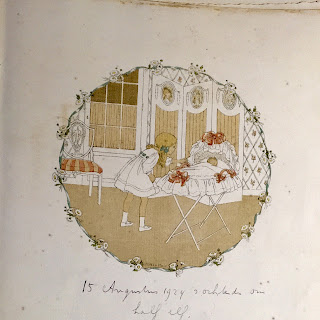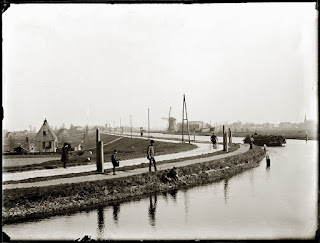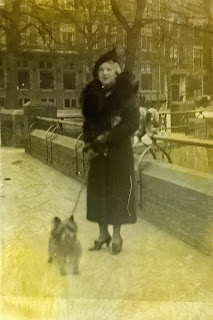Youngest
The prompt for week 32 - Youngest - offers a few options: the youngest child in the family, any ancestors who were the youngest in their family, the most recent document.
My grandparents on my father's side were each the youngest in their families, and my father was their first born. I have already written a bit about my grandparents in other posts, so for this one I'll look for more recent documents and this happens to be my father's baby book, entitled "Eerste Levensjaren" and also the baby instruction manual my mother received from the family in Holland when she was expecting me, in Calcutta, India.
The baby book "Eerste Levensjaren" - Early Years - was first published in 1910 in Dutch and features five illustrations by Henriette Willebeek le Mair, a not so well known illustrator who gained more appreciation for her work in later years, or so it seems from what I've quickly googled. (Henriette Willebeek le Mair - ongekend talent)
This album has lived well and truly and so is quite damaged. At first sight it looks like it has fallen apart, but it is a loose-leaf publication that was bound by a ribbon (as I could see from an image on the internet) now lost so it is held together by string.
Illustrated is part of the first page inscribed by my grandmother, recording dad's birth at 10.30 am on 15th August 1924. He raised his hand up in the air and his voice as well!
He weighed eight pounds at birth and was a contented baby though after a few days needed extra feeds.
Mother and son did not go home till about ten days after the birth. Quite different from modern practices.
The book is obviously designed to be like a diary with some charts and lists for mother to fill in, and my grandmother did but mostly it is blank pages that are decorated with a border.
The next page is a record of weight for each of the four children in the family. The next son, Cees, weighed in at six and a half pounds, and then Henk beat dad's weight at 8 pounds 150 gram and finally Lien weighed in at 7 pound 40 gram.
The page listing "first words" is interesting, Mama of course but also Boy, name of the pet dog.
There is also a very basic sketch of the family tree, going back to my great grandparents, and it is hard to read. My grandmother had terrible handwriting, but it shows that she probably knew many of these family members.
The other baby book, titled simply "Het Baby Boek voor de huisvrouw hier en overzee" - The baby book for the housewife here and overseas - is really a guide or manual for taking care of baby.
It has some adaptations for the tropical climate, such as mosquito nets and also a recipe for a rice based porridge, nassi tim, which looks more nutritious than the milk porridge recipe. It is made with 1 tablespoon rice, a bunch of chopped green leafy vegetables or 4 or 5 carrots, one cup of water and some salt or half a Maggi cube (stock). The whole lot is steamed for two to three hours! Then pureed.
Borax, spread in the corners, is suggested against cockroaches and also anti-ant cups under each of the cot legs to prevent an invasion. There are warnings about watching for baby getting tangled in the mosquito net over their beds and quite specific instructions for sun bathing and bathing baby in a tub in the garden.
Instructions for washing in the tropics advise using the powers of the sun - to sterilise, to bleach, for stain removal. It seems that washing directly in the rivers and creeks was quite usual in the Dutch East Indies, but mothers are warned not to do this with baby clothes because of pollution in the water.
A few chapters reflect the recent history at the time. There is a poem titled "Kind in 't interneringskamp" - Child in the prison camp - the Dutch East Indies were occupied by the Japanese 1942-1945.
Another chapter is about babies in overcrowded housing. It sets the scene in a large former Dutch East Indies house, that was once the residence of one family, but now (post war) has become home to several families with small children, crying babies, fearful mothers - because of the political situation - and short-tempered fathers. A visitor to a family in the house observes the prevailing stress and tension and offers her advice - basically, all women (and men) are in this together, rather than complain and get angry, roll up your sleeves and help each other out.
There are lots of patterns for baby clothes, wall hangings, decorated bibs, clothes for mum (quite elegant as well as comfortable), toys and other crafts. Tucked in the back are the patterns my mother cut, some are from Calcutta newspapers. These appear to be published around 15th August, India's official Independance Day. Some headlines: Chinese Communists in full control of west Tibet, Hitler's Yacht, USA to Push Cotton Exports.
At the end are pages with charts and lists for noting memorable moments and key statistics. My mother noted my birth weight as 8 pd 6 oz. I took after my dad.
Bibliography:
De eerste Levensjaren, met teekeningen van Henriette Willebeek le Mair, Rotterdam, Nijgh & van Ditmar's Uitgevers Maatschappij
CM Pasteur - van Swieten, Het Baby Boek voor de Huisvrouw, Hier en Overzee, Uitgeverij Jacob van Campen, Amsterdam, vierde druk, 1950
 |
| First Day - from Eerste Levensjaren. In personal family collection. |
The baby book "Eerste Levensjaren" - Early Years - was first published in 1910 in Dutch and features five illustrations by Henriette Willebeek le Mair, a not so well known illustrator who gained more appreciation for her work in later years, or so it seems from what I've quickly googled. (Henriette Willebeek le Mair - ongekend talent)
This album has lived well and truly and so is quite damaged. At first sight it looks like it has fallen apart, but it is a loose-leaf publication that was bound by a ribbon (as I could see from an image on the internet) now lost so it is held together by string.
Illustrated is part of the first page inscribed by my grandmother, recording dad's birth at 10.30 am on 15th August 1924. He raised his hand up in the air and his voice as well!
He weighed eight pounds at birth and was a contented baby though after a few days needed extra feeds.
Mother and son did not go home till about ten days after the birth. Quite different from modern practices.
The book is obviously designed to be like a diary with some charts and lists for mother to fill in, and my grandmother did but mostly it is blank pages that are decorated with a border.
The next page is a record of weight for each of the four children in the family. The next son, Cees, weighed in at six and a half pounds, and then Henk beat dad's weight at 8 pounds 150 gram and finally Lien weighed in at 7 pound 40 gram.
 |
| A family tree. Personal family collection. |
There is also a very basic sketch of the family tree, going back to my great grandparents, and it is hard to read. My grandmother had terrible handwriting, but it shows that she probably knew many of these family members.
The other baby book, titled simply "Het Baby Boek voor de huisvrouw hier en overzee" - The baby book for the housewife here and overseas - is really a guide or manual for taking care of baby.
It has some adaptations for the tropical climate, such as mosquito nets and also a recipe for a rice based porridge, nassi tim, which looks more nutritious than the milk porridge recipe. It is made with 1 tablespoon rice, a bunch of chopped green leafy vegetables or 4 or 5 carrots, one cup of water and some salt or half a Maggi cube (stock). The whole lot is steamed for two to three hours! Then pureed.
Borax, spread in the corners, is suggested against cockroaches and also anti-ant cups under each of the cot legs to prevent an invasion. There are warnings about watching for baby getting tangled in the mosquito net over their beds and quite specific instructions for sun bathing and bathing baby in a tub in the garden.
Instructions for washing in the tropics advise using the powers of the sun - to sterilise, to bleach, for stain removal. It seems that washing directly in the rivers and creeks was quite usual in the Dutch East Indies, but mothers are warned not to do this with baby clothes because of pollution in the water.
 |
| Designs for cots so baby can spend time in the garden. From Het Baby Boek voor de Huisvrouw Hier en Overzee Personal family collection. |
A few chapters reflect the recent history at the time. There is a poem titled "Kind in 't interneringskamp" - Child in the prison camp - the Dutch East Indies were occupied by the Japanese 1942-1945.
Another chapter is about babies in overcrowded housing. It sets the scene in a large former Dutch East Indies house, that was once the residence of one family, but now (post war) has become home to several families with small children, crying babies, fearful mothers - because of the political situation - and short-tempered fathers. A visitor to a family in the house observes the prevailing stress and tension and offers her advice - basically, all women (and men) are in this together, rather than complain and get angry, roll up your sleeves and help each other out.
There are lots of patterns for baby clothes, wall hangings, decorated bibs, clothes for mum (quite elegant as well as comfortable), toys and other crafts. Tucked in the back are the patterns my mother cut, some are from Calcutta newspapers. These appear to be published around 15th August, India's official Independance Day. Some headlines: Chinese Communists in full control of west Tibet, Hitler's Yacht, USA to Push Cotton Exports.
At the end are pages with charts and lists for noting memorable moments and key statistics. My mother noted my birth weight as 8 pd 6 oz. I took after my dad.
Bibliography:
De eerste Levensjaren, met teekeningen van Henriette Willebeek le Mair, Rotterdam, Nijgh & van Ditmar's Uitgevers Maatschappij
CM Pasteur - van Swieten, Het Baby Boek voor de Huisvrouw, Hier en Overzee, Uitgeverij Jacob van Campen, Amsterdam, vierde druk, 1950




Comments
Post a Comment